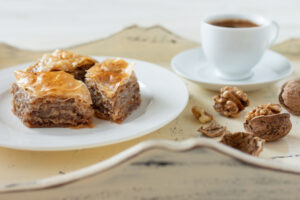
It might seem hard to believe, but there are folks out there who don’t know what baklava is. I’ll try to be brief.
Baklava is a pastry that is comprised of layers of very thin dough, generally baked in clarified butter and soaked in syrup or honey. It generally has a perfuming using rosewater, orange flower water, lemon juice, and in ancient times, musk (if you were alive during the 80s, you’re likely familiar with “Jovan Musk,” a favorite scent of the era). Don’t let the term “perfuming” scare you. It is incredibly subtle, more like “spicing.” The original recipes most likely originated on the nomadic Turkic plains of Central Asia, Mongolia, and China. If you’d like, you can watch this 30 minute video, which will give you a more academic explanation. The Sultan of Sweets: The history and story of baklava.
Many cultures claim ownership of the invention of baklava, although my research tells me it is likely Turkic in nature.

Most of us here in the U.S. are familiar with the baklava you see above. But it has many, many variations, and can use almonds, pistachios, hazelnuts, cheese, and in some cases, an inferior baklava made here contains cashews and peanuts (although I’ve seen peanut baklava in Turkey and it’s not considered inferior). There are even versions that use lentils (see the video above) and jam, marmalade, or marzipan fillings.